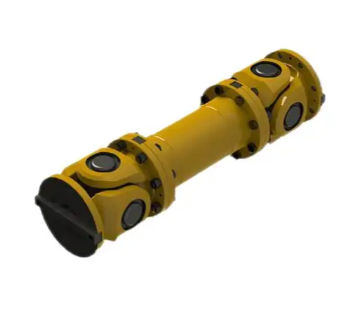Definition and Core Functionality of Flexible Couplings
Transmitting Torque Between Shafts
Flexible couplings are essential components in machinery that enable the transmission of torque between two shafts while allowing for relative motion. This feature is crucial for smooth power transmission in mechanical systems, as it not only connects shafts but also accommodates minor misalignments that may exist between them. By doing so, flexible couplings help in reducing shock loads during operation, which minimizes wear and tear on critical components. Research indicates that effective torque transmission, facilitated by these couplings, can significantly enhance the longevity and reliability of equipment. Choosing the right type of flexible coupling is, therefore, vital for ensuring optimal performance.
Accommodating Angular and Parallel Misalignment
One of the key benefits of flexible couplings is their ability to manage both angular and parallel misalignment between shafts. This characteristic is crucial for maintaining system efficiency and protecting related drive components. By accommodating misalignments, flexible couplings reduce stress on mechanical systems, thereby minimizing potential downtimes and maintenance costs. According to engineering reports, misalignment can lead to increased vibration and noise, which can impair machine performance. Therefore, the role of flexible couplings is vital in ensuring optimal machinery operation by mitigating the effects of misalignment.
Key Components and Working Mechanism
Hub and Elastomeric Elements
In the realm of flexible coupling technology, the hub serves as a pivotal component. It is designed to connect the flexible coupling to the shafts, often incorporating features that allow for the easy attachment of various shaft sizes. This adaptability is crucial in accommodating different industrial requirements and ensuring a snug fit that facilitates efficient power transmission. Coupled with hubs are elastomeric elements, which play a significant role in providing flexibility. These elements absorb vibrations and can accommodate minor misalignments between shafts, reducing wear and tear on machinery. Recent advancements in material science have led to the development of elastomer materials that enhance operational characteristics. Such materials are known for their resilience and longevity, contributing to more durable and efficient coupling systems.
Compensating for Shaft Displacement via Flexibility
Flexible couplings are ingeniously designed to accommodate small angular, radial, and axial displacements, which is vital for the dynamic operations of machinery. Their ability to manage these displacements mitigates risks associated with excess stress or shaft misalignment, which are common issues in many industrial applications. This inherent flexibility not only reduces the potential for system failures but also enhances the overall safety and reliability of machinery operations. Statistical data reiterates that machinery equipped with effective flexible coupling systems often experiences fewer operational disruptions. This reduction in disruptions is crucial for maintaining seamless production processes, thereby highlighting the role of these couplings in industrial settings.
Types of Flexible
Elastomeric Couplings (Vibration Damping)
Elastomeric couplings are crafted with rubber-like materials, providing exceptional vibration damping capabilities essential for vibration-sensitive applications. These couplings mitigate noise and reduce wear, ensuring smoother operations across various machinery. This feature significantly enhances equipment performance and lifespan by minimizing vibration-induced damages. According to research in mechanical engineering, elastomeric couplings not only improve operational efficiency but also extend the overall lifespan of machinery by effectively absorbing vibrations and misalignments. Thus, they are a popular choice in applications where vibration damping is critical.
Metallic Couplings (High-Torque Applications)
Metallic couplings are ideal for high-torque applications due to their robust construction, which can withstand significant stress without deformation. These couplings possess an extended service life, particularly in demanding environments, compared to elastomeric alternatives. Industry analyses have consistently demonstrated that incorporating metallic couplings in heavy machinery enhances reliability and performance, especially under high-load conditions. This increased mechanical resilience makes metallic couplings a primary choice for industrial applications where durability and high torque are paramount.
Universal Joints for Complex Misalignment
Universal joints are a specialized type of flexible coupling designed to manage complex misalignment configurations. Their ability to articulate allows for efficient torque transmission even when shafts are misaligned across multiple planes. These valuable components are especially prevalent in automotive and industrial settings, where complex orientations are common. Expert opinions from the field of automotive engineering underscore the critical role of universal joints in maintaining the operational integrity of diverse vehicles and equipment types. Their ability to adapt to various misalignment angles ensures consistent performance and reduced mechanical failures in dynamic systems.
Common Applications in Modern Machinery
Industrial Power Transmission Systems
Flexible couplings play a crucial role in industrial power transmission systems by enhancing torque transfer and accommodating misalignments. They are commonly used in machinery such as conveyors, pumps, and heavy equipment, ensuring efficient energy use and reducing mechanical failures. Industries employing these couplings often report lower operational disruptions, which in turn enhances productivity. For example, case studies indicate that manufacturing sectors using flexible couplings experience fewer downtimes and maintenance issues, leading to smoother and more reliable operations.
Automotive and Precision Equipment
In the automotive industry, flexible couplings are essential for maintaining reliable connections that adapt to engine movements while efficiently transmitting power to various components. They are also utilized in precision equipment, allowing enhanced control and accuracy within complex mechanical systems. Statistics demonstrate that automotive companies utilizing advanced flexible coupling technologies achieve higher performance standards and durability. This adaptability not only benefits the vehicle's performance but also boosts the longevity of its components, providing a competitive edge in the market.
Selection Criteria and Best Practices
Evaluating Torque and Speed Requirements
When selecting a flexible coupling for specific applications, it is crucial to evaluate the torque and speed requirements to ensure compatibility. This process involves understanding the maximum permissible torque and the expected operating speeds of the system. Failing to consider these factors could result in coupling failure, which can lead to system breakdowns and financial losses. According to mechanical design experts, proper torque and speed evaluation not only prevents malfunctions but also enhances the overall performance and longevity of the machinery. This approach ensures that the chosen coupling adequately supports the operational demands of the system, minimizing the risk of unexpected downtime.
Environmental Factors and Maintenance Considerations
Environmental conditions are vital in the selection of flexible couplings, as factors such as temperature, humidity, and chemical exposure significantly influence performance. For instance, extreme temperatures may cause materials to expand or contract, potentially leading to alignment issues. Hence, it's necessary to choose couplings that can withstand specific environmental conditions to avoid premature deterioration. Regular maintenance further ensures the optimal performance of the couplings throughout their lifespan. Manufacturers often provide comprehensive guidelines on best practices for maintaining couplings, emphasizing the importance of routine checks and adjustments. Adhering to these practices not only maintains performance efficiency but also significantly extends the life of the couplings, reducing the likelihood of mechanical failures.
FAQs
What are flexible couplings used for?
Flexible couplings are used to transmit torque between shafts in machinery, accommodating minor misalignments and providing smooth power transmission.
How do flexible couplings reduce wear and tear on machinery?
Flexible couplings reduce wear and tear by absorbing shock loads and accommodating misalignments, which decreases stress on connected components.
What types of flexible couplings are available?
Common types include elastomeric couplings for vibration damping, metallic couplings for high-torque applications, and universal joints for managing complex misalignments.
How can flexible couplings enhance the longevity of machinery?
By effectively transmitting torque and accommodating misalignments, flexible couplings can enhance machinery longevity and reliability.
What should be considered when selecting flexible couplings?
Considerations include evaluating torque and speed requirements, environmental factors like temperature and humidity, and planned maintenance procedures.

